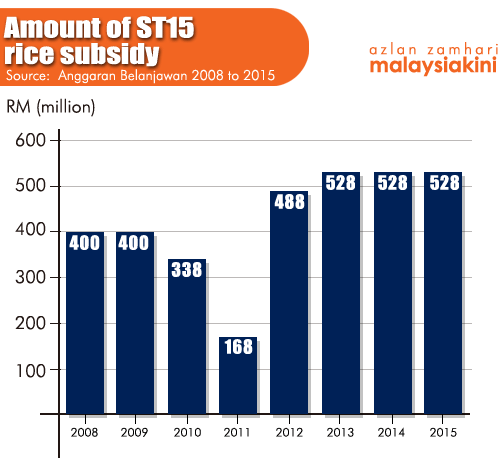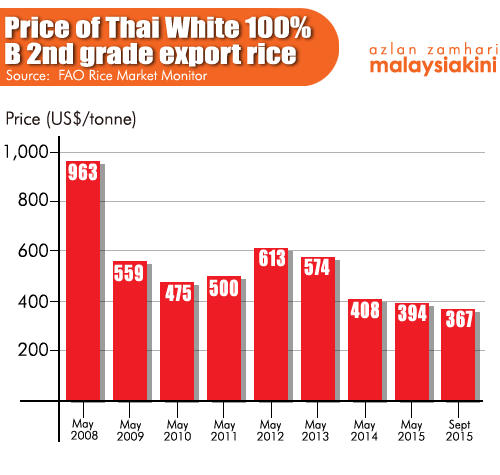MP SPEAKS The announcement by the Agriculture Ministry that the subsidy for the Super Tempatan 15 percent (ST15) broken rice has been abolished is not surprising. In the 2016 Budget estimates, the RM528 million subsidi harga beras in 2015 was reduced to zero in 2016.
It was reported that the Agriculture and Agro-Based Industry Ministry’s Padi and Rice Industry Division secretary, Samsuddin Ismail, had said that the programme was abolished because there were too many leakages in the scheme including the rice being bought by non-Malaysians and by food eateries.
 Since this subsidy was introduced in 2008 to 2015, an estimated RM3.4 billion has been spent. If there were leakages in this subsidy, how much of this subsidy was wasted? How much did this subsidy benefit restaurant owners who would gain additional profit from using this subsidised low grade rice? How much of this subsidy went to unscrupulous middle-men who bought ST15 subsidized rice and repackaged them to see it at a higher grade and higher price?
Since this subsidy was introduced in 2008 to 2015, an estimated RM3.4 billion has been spent. If there were leakages in this subsidy, how much of this subsidy was wasted? How much did this subsidy benefit restaurant owners who would gain additional profit from using this subsidised low grade rice? How much of this subsidy went to unscrupulous middle-men who bought ST15 subsidized rice and repackaged them to see it at a higher grade and higher price?
The Agriculture Ministry must explain to the Malaysian taxpayer.
This subsidy was introduced in 2008 when the price of rice was at a historic high. According to statistics from the United Nation’s Food and Agriculture (FAO) Rice Market Monitor, the price of Thai White 100 percent B 2nd grade export rice hit a high of US$963/tonne in May 2008. Since then, the price has dropped to US$367 in September 2015.
 This ST15 subsidy was channelled through Bernas whose main responsibility was to ensure a steady supply of ST15 rice given the then historically high price of rice in the international market. But since the price of rice has dropped by more than 50 percent since 2008, how much of this subsidy has gone into the bottom line of Bernas itself?
This ST15 subsidy was channelled through Bernas whose main responsibility was to ensure a steady supply of ST15 rice given the then historically high price of rice in the international market. But since the price of rice has dropped by more than 50 percent since 2008, how much of this subsidy has gone into the bottom line of Bernas itself?
Shockingly, when the price of rice in the international market for Thai 100 percent B had dropped to less than RM410 in 2014 and 2015, the subsidy for ST15 was maintained at RM528 million for 2014 and 2015. Was this a subsidy to help the poor buy cheap rice or was it a subsidy to benefit Bernas directly? The Agriculture Ministry must also explain.
Finally, the prime minister, in his budget speech announced that the government will increase the rate of the padi subsidy to farmers (or Skim Subsidi Harga Padi) from RM248.10 to RM300 per tonne.
This is supposed to translate into increasing a farmer’s income from RM1,190 to RM1,440. But when the allocation of the Subsidi Harga Padi in the Anggaran Belanjawan is examined, we find that this has actually been cut from RM480 million in 2015 to RM400 million in 2016. How can this be consistent with Najib Abdul Razak’s announcement that the padi farmers’ incomes will be increased?
Quota system?
Will the Agriculture Ministry impose a quota system so that fewer farmers are eligible for this subsidy scheme since there are an estimated 172,330 padi farmers in Malaysia whereas Najib’s plan will only benefit 155,000 padi farmers?
In Pakatan Harapan’s 2016 Budget, we advocate for the transfer of the ST15 subsidy to the farmers because of the leakages experienced in this subsidy scheme and because the padi subsidy to the farmers has not been increased since 1991.
We feel that this is a more equitable way of allocating the subsidy. And the income of the poor will be significantly increased via the abolishment of the GST compared to the ST15 subsidy scheme which does not even get channelled to the poor communities.
ONG KIAN MING is DAP's MP for Serdang.

